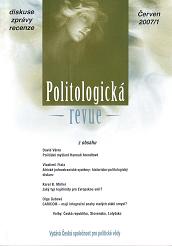Volby 2006 a změna vlády na Slovensku
Elections 2006 and the Change of Govemment in Slovakia
Author(s): Pavel HynčicaSubject(s): Politics / Political Sciences
Published by: Česká společnost pro politické vědy
Keywords: elections; cleavages; coalitions; Slovakia
Summary/Abstract: The political development in Slovakia was influenced by many specific factors in the 1990s. This development after 2002 has been characterized by many changes compared to the 90s, first of all by the consolidation of the socio-economic cleavage with subsequent formation of the socialist (SMER) and non-socialist (SDKU) poles. SMER and SDKU were dominant political parties in parliamentary elections in 2006; these parties had very different points of view and interests, first of all in the area of economic policy. SMER gained most of the votes because it successfully took advantage of its protest potential. However, also SDKU was successful in these elections. Besides SMER and SDKU, other parties (SNS, SMK, HZDS, KDH) represent important elements of the Slovak party system as representatives of minor cleavages. SNS and SMK obtained about 11% of the votes. SNS is a nationalist party and SMK is a party of Hungarian ethnic minority. Other relevant parties HZDS and KDH pertained to the least voted (about 8-9% each). These parties did not have clear and important program topics and effective strategic advance. After elections, the coalition of SMER-SNS-HZDS was formed. These new coalition parties did not have too different programmes (in particular in the economic and social area). ldentical profit from power and influence was another important factor to formation oj government based on the coalition of these three parties.
Journal: Politologická revue
- Issue Year: 13/2007
- Issue No: 1
- Page Range: 129-150
- Page Count: 22
- Language: Czech
- Content File-PDF

